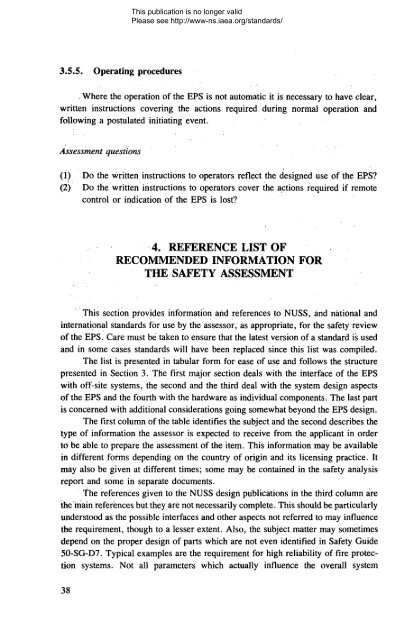SAFETY P R A C TIC E S - gnssn - International Atomic Energy Agency
SAFETY P R A C TIC E S - gnssn - International Atomic Energy Agency
SAFETY P R A C TIC E S - gnssn - International Atomic Energy Agency
Create successful ePaper yourself
Turn your PDF publications into a flip-book with our unique Google optimized e-Paper software.
This publication is no longer validPlease see http://www-ns.iaea.org/standards/3.5.5. Operating procedures. Where the operation of the EPS is not automatic it is necessary to have clear,written instructions covering the actions required during normal operation andfollowing a postulated initiating event.Assessment questions(1) Do the written instructions to operators reflect the designed use of the EPS?(2) Do the written instructions to operators cover the actions required if remotecontrol or indication of the EPS is lost?4. REFERENCE LIST OFRECOMMENDED INFORMATION FORTHE <strong>SAFETY</strong> ASSESSMENTThis section provides information and references to NUSS, and national andinternational standards for use by the assessor, as appropriate, for the safety reviewof the EPS. Care must be taken to ensure that the latest version of a standard is usedand in some cases standards will have been replaced since this list was compiled.The list is presented in tabular form for ease of use and follows the structurepresented in Section 3. The first major section deals with the interface of the EPSwith off-site systems, the second and the third deal with the system design aspectsof the EPS and the fourth with the hardware as individual components. The last partis concerned with additional considerations going somewhat beyond the EPS design.The first column of the table identifies the subject and the second describes thetype of information the assessor is expected to receive from the applicant in orderto be able to prepare the assessment of the item. This information may be availablein different forms depending on the country of origin and its licensing practice. Itmay also be given at different times; some may be contained in the safety analysisreport and some in separate documents.The references given to the NUSS design publications in the third column arethe main references but they are not necessarily complete. This should be particularlyunderstood as the possible interfaces and other aspects not referred to may influencethe requirement, though to a lesser extent. Also, the subject matter may sometimesdepend on the proper design of parts which are not even identified in Safety Guide50-SG-D7. Typical examples are the requirement for high reliability of fire protectionsystems. Not all parameters which actually influence the overall system38
















